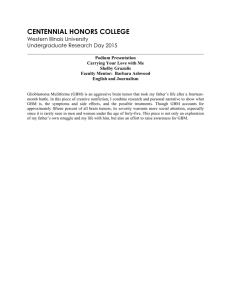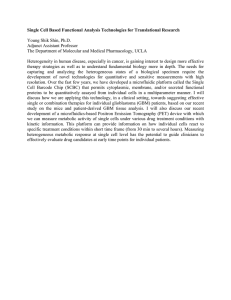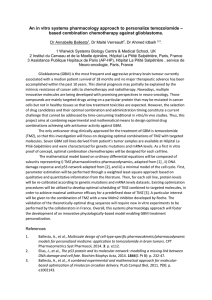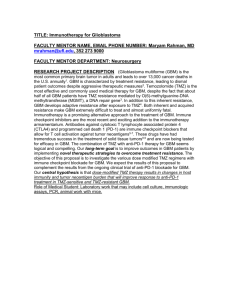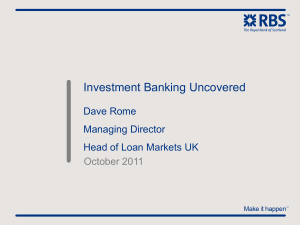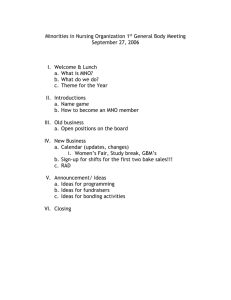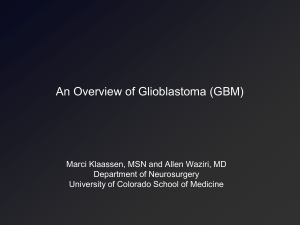Highlights and Selected Abstracts from SNO 2014
advertisement
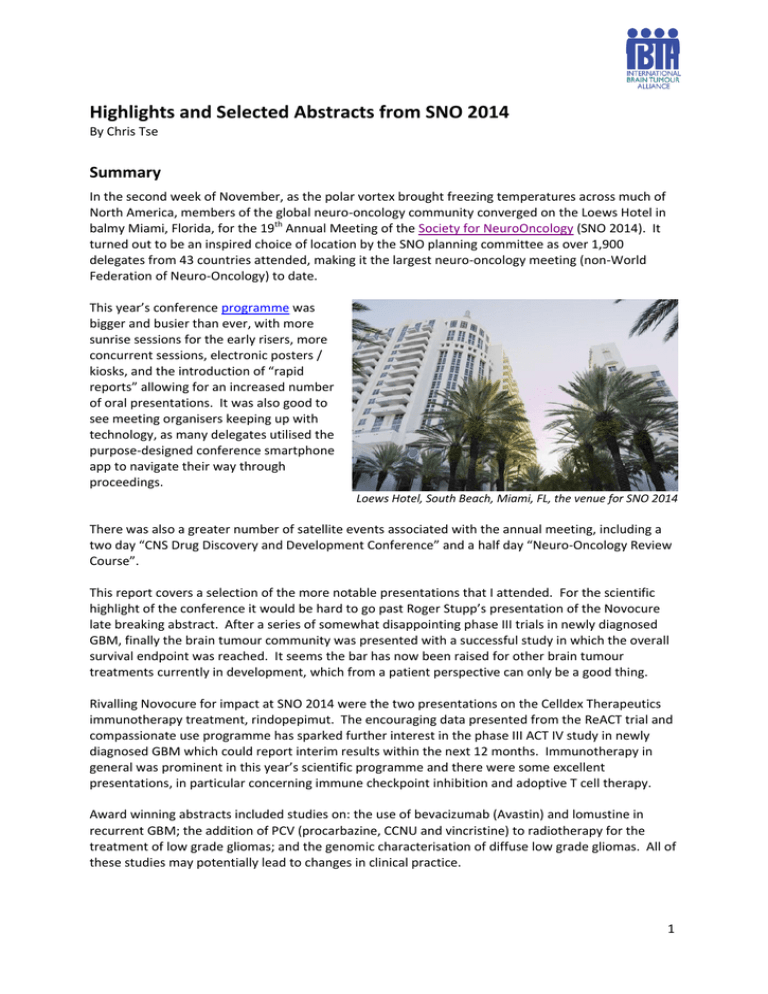
Highlights and Selected Abstracts from SNO 2014 By Chris Tse Summary In the second week of November, as the polar vortex brought freezing temperatures across much of North America, members of the global neuro-oncology community converged on the Loews Hotel in balmy Miami, Florida, for the 19th Annual Meeting of the Society for NeuroOncology (SNO 2014). It turned out to be an inspired choice of location by the SNO planning committee as over 1,900 delegates from 43 countries attended, making it the largest neuro-oncology meeting (non-World Federation of Neuro-Oncology) to date. This year’s conference programme was bigger and busier than ever, with more sunrise sessions for the early risers, more concurrent sessions, electronic posters / kiosks, and the introduction of “rapid reports” allowing for an increased number of oral presentations. It was also good to see meeting organisers keeping up with technology, as many delegates utilised the purpose-designed conference smartphone app to navigate their way through proceedings. Loews Hotel, South Beach, Miami, FL, the venue for SNO 2014 There was also a greater number of satellite events associated with the annual meeting, including a two day “CNS Drug Discovery and Development Conference” and a half day “Neuro-Oncology Review Course”. This report covers a selection of the more notable presentations that I attended. For the scientific highlight of the conference it would be hard to go past Roger Stupp’s presentation of the Novocure late breaking abstract. After a series of somewhat disappointing phase III trials in newly diagnosed GBM, finally the brain tumour community was presented with a successful study in which the overall survival endpoint was reached. It seems the bar has now been raised for other brain tumour treatments currently in development, which from a patient perspective can only be a good thing. Rivalling Novocure for impact at SNO 2014 were the two presentations on the Celldex Therapeutics immunotherapy treatment, rindopepimut. The encouraging data presented from the ReACT trial and compassionate use programme has sparked further interest in the phase III ACT IV study in newly diagnosed GBM which could report interim results within the next 12 months. Immunotherapy in general was prominent in this year’s scientific programme and there were some excellent presentations, in particular concerning immune checkpoint inhibition and adoptive T cell therapy. Award winning abstracts included studies on: the use of bevacizumab (Avastin) and lomustine in recurrent GBM; the addition of PCV (procarbazine, CCNU and vincristine) to radiotherapy for the treatment of low grade gliomas; and the genomic characterisation of diffuse low grade gliomas. All of these studies may potentially lead to changes in clinical practice. 1 Other major topics covered over the course of the meeting included: tumour metabolism; molecular classification of tumours; RANO (Response Assessment in Neuro-Oncology) and clinical trial endpoints; tumour biology; neuro-imaging; and paediatric brain tumours. There is progress being made in all of these areas and brain tumour patients and their families can take heart from the prospect that new treatment options could be just around the corner. Overall the 2014 annual meeting ran very smoothly and credit must once again go to SNO Executive Director Chas Haynes and his dedicated team consisting of: Jan Esenwein, Linda Greer, Megan Bell, Elizabeth Haynes and Kristin Odom. The 20th Annual Meeting of the Society for Neuro-Oncology has been confirmed for 17-22 November 2015 in San Antonio, Texas. Education Day (Thursday 13 Nov) The Education Day programme was split into two tracks: “Metastasis to the CNS: Biology and Consequences” and “Quality of Life”. Brain metastases are widely regarded as difficult to treat, with far fewer treatment options available to the oncologist compared with primary brain tumours, so it was good to see the meeting organisers focus on this area. In the Quality of Life Breakout, some considerable attention was given to caregivers, not only in regards to the important role they provide in patient care but also in providing support to the caregivers themselves. There were some excellent presentations from Paula Sherwood (University of Pittsburgh, USA), Petra Hoogendoorn (Twente University, the Netherlands), Kim Wallgren (CERN Foundation, USA) and Helen Bulbeck (brainstrust, UK) on this subject. Paula Sherwood spoke about the major health risk factors for caregivers, including depression, anxiety, stress, caregiver burden and emotional health. She said neuro-oncology caregivers had a lot in common with dementia caregivers but were essentially unique in the challenges they faced. Petra Hoogendoorn asked: “Who cares about the caregivers?” and advocated a caregiver bill of rights. Kim Wallgren recommended doctors adopt a humanistic approach and reminded them to always treat patients and caregivers with kindness and respect. Helen Bulbeck spoke about “the carer led solution” or placing the carer in the role of expert. Her advice for providing support to carers was “to listen, listen some more, then ask some simple questions, such as: • Right now, at this very moment, how are you? • What are you struggling with? What else? What else? • What are you frightened of? • What do you want to achieve? • How do you want to be in the time you have left? • What do you want to say to each other? What makes it hard? • Who can help you? The Education Day sessions concluded with the two tracks coming together for a joint session titled: “Neurological Complications of Metastatic Disease”. Later on Thursday evening, a session titled: “Preparing a Phase I/II Clinical Trial” was run by Susan Chang, Martin van den Bent and Karla Ballman. The day’s proceedings concluded with the official Welcome Reception held outdoors on the glamorous Americana Lawn of the Loews Hotel, Miami Beach. Plenary Session 1 (Friday 14 Nov, morning) Following five concurrently held Sunrise Sessions, the Friday morning plenary session got underway with presentations of the Top Scoring Abstracts and Travel Awards. 2 Abstract No. AT-55: “Final analysis of the BELOB trial (A randomized phase II study on bevacizumab versus bevacizumab plus lomustine versus lomustine single agent in recurrent glioblastoma) and first radiology review results” was presented by Martin van den Bent. He reported positive survival data for the combination of bevacizumab and lomustine and concluded that further investigation was warranted. A phase III trial (EORTC 26101) is currently underway in Europe. Abstract No. AT-13: “R9802: Phase III study of radiation therapy (RT) with or without procarbazine, CCNU, and vincristine (PCV) in low-grade glioma: Results by histologic type” was presented by Jan Buckner. This presentation expanded on an earlier announcement at ASCO in June 2014 which showed that the combination of radiotherapy (RT) and PCV (procarbazine, CCNU and vincristine) prolonged both PFS and OS compared with RT alone in patients with low grade glioma (LGG). The treatment effect was greatest in patients with oligodendroglioma (O) and oligoastrocytoma (OA) where the study achieved statistical significance. Investigators are now focusing on assessing the outcomes by molecular markers, in particular IDH mutations and 1p/19q co-deletion. The Adult Epidemiology Research Award was awarded to Abstract No. ED-36: “Inherited variants near TERC and TERT are associated with longer telomeres and increased glioma risk: genome-wide association results from the UCSF Adult Glioma Study and the ENGAGE Consortium Telomere Group” which was presented by Kyle Walsh. This study identified three new SNPs (single nucleotide polymorphisms) located near TERC, TERT and RTEL1 which were associated with increased high grade glioma risk. These findings suggest that inherited variations in telomere length or telomerase activity may underlie glioma susceptibility. Abstract No. GE-41: “Comprehensive and integrative genomic characterisation of diffuse lower grade gliomas” was presented by Roel Verhaak. This study found that molecular characterisation of low grade gliomas (LGG) points toward three distinct subtypes which traversed grades and histologies: • IDH wildtype – GBM like, poor outcome • IDH mutant with 1p/19q codeletion – mostly oligodendroglioma; TERT promoter mutations • IDH mutant non 1p/19q codeletion – TP53 and ATRX mutations, mixed grade and histology They concluded that IDH1, IDH2 mutation status and 1p/19q ploidy are routinely determined in the clinical setting, making these three subtypes highly practical to implement, and proposed that classification of LGG be revised based on these molecular characteristics. After the morning tea break, Ken Aldape delivered the Abhijit Guha Lecture with a speech titled: “Neuropathologists: Who Needs Them?” This was followed by this year’s recipient of the Victor Levin Award, Michael Prados, who was fittingly introduced by Victor Levin. In a departure from recent lectures, Prados gave a non-technical speech entitled: “Success or Significance”. He characterised success as: “Often identified by personal milestones; focuses on individual achievements; can ebb and flow, often never enough”. He explained that significance: “Lasts, carries on beyond success, Victor Levin introduces 2014 Victor Levin Award winner, Michael Prados and beyond personal milestones; can take us out of our comfort zone; and once achieved, not much 3 else satisfies”. He highlighted the difference between success and significance by using the example of clinical trials, noting: “successful trials may not be significant in terms of the patient’s perspective but negative trials may be very significant”. He said successes that become significant should be a major goal for the research community. In his President’s Address, David Reardon summarised a very busy and successful year for the Society. He thanked the organisers of the 2014 meeting, in particular scientific co-chairs Gelareh Zadeh and Patrick Wen, Education Day co-chairs Louis Burt Nabors, David Schiff, Eudocia Quant Lee, Terri Armstrong and Alasdair Rooney, and the SNO staff led by Chas Haynes. He confirmed also that Gelareh Zadeh will co-chair the scientific programme for the 2015 meeting, together with Tracy Batchelor. The 20th annual SNO meeting will be held in San Antonio, Texas, on 17-22 November 2015. On a sad note, Reardon paid tribute to Dr Nicholas Vick, who he described as “a patriarch in our field” and who passed away earlier this year after a distinguished 43 year career in neuro-oncology. Two awards were presented, with the first being a Lifetime Achievement Award to Darell Bigner (Duke University, USA). In his gracious acceptance speech, Bigner shared his glimpse of the future of neuro-oncology, saying he believed that in the next ten years there will be a sea change in helping our patients. He said that we won’t be talking about “chemotherapy” but “immunotherapy” and he encouraged everyone to train in immunology. He also urged more collaboration, challenging everyone to put aside their egos and truly work as a team. The second award was a Public Service Award awarded to the former chair of the International Brain Tumour Alliance (IBTA), Denis Strangman (Australia). In Denis’s absence his award was accepted on his behalf by prominent Sydney neuro-oncologist, Dr Helen Wheeler. Following the President’s Address, there were brief presentations by Rick Sontag, co-founder and president of the Sontag Foundation, who announced a new initiative for US brain tumour patients called the Brain Tumor Network, and David Arons from the National Brain Tumor Society. This concluded the Friday morning plenary session. At SNO there are several tutorials, meetings and presentations scheduled over the lunch break. One such presentation over the Friday lunch break was “Importance of Brain and CNS Tumor Statistics for Translational Research” by Dr Jill Barnholtz-Sloan on behalf of the Central Brain Tumor Registry of the United States (CBTRUS). CBTRUS is the sole source of yearly comprehensive population-based incidence data for brain tumours in the US, providing accurate and complete incidence by histology, gender, age, race and behaviour (malignant or non-malignant). Some notable findings arising from their 2014 studies were: • Approximately 42% of all tumors occurred in males and 58% in females. • The overall average annual age-adjusted incidence rate for all primary brain and CNS tumors was 21.42 per 100,000. 7.25 per 100,000 for malignant tumors 14.17 per 100,000 for non-malignant tumors • The most frequently reported histology was meningioma (36.1%) followed by glioblastoma (15.4%). With regard to trends in incidence: • In adults, there were decreases in incidence of colon, breast, lung, and prostate cancer, as well as malignant brain tumors. • In adolescents (15-19), there were increases in incidence of malignant and non-malignant brain-tumors. • In children (0-14), there were increases in incidence of acute lymphocytic leukemia, nonHodgkin lymphoma, and malignant brain tumors. 4 With regard to paediatric tumours: • Childhood brain tumors are the most common cancer in children 0-14. • The most common types of brain tumors in children are gliomas (52.9%) and embryonal tumors (15.0%). • Incidence of brain tumors is highest among infants < 1 year old With regard to years of life lost/lived: • Among cancer deaths, brain and CNS tumors caused the greatest proportion of years of potential life lost (31%), followed by leukemia. • Gliomas (in particular high grade glioma) were the biggest contributor to years of life lost • Brain tumor histologies that led to death varied significant by age Embryonal tumors most common in infants, gliomas at all other ages CBTRUS Founder and President, Carol Kruchko, and CEO Christine Cholewa were also present to expand on the organisation’s current and future activities and to answer questions from the audience. Session 2A – Clinical Trials (Friday 14 Nov, afternoon) The Friday afternoon sessions were split into three concurrent tracks: Session 2A/3A “Clinical Trials”; Session 2B/3B “Preclinical Models and Biological Therapeutics”; and Session 2C “Pediatric - Tumor Biology” and session 3C “Paediatrics – Clinical”. Abstract AT-23: “A phase II study of lapatinib and dose-dense temozolomide (TMZ) for adults with recurrent ependymoma: A CERN clinical trial” presented by Mark Gilbert. This study involved 50 patients with ependymoma of varying grades and locations. The results showed that the combination of dose-dense temozolomide and lapatinib is well tolerated and shows promising efficacy, with four objective responses and encouraging PFS rates, “some of very long duration”. The logical next step is to investigate predictive molecular markers as some patients had early failure while others had prolonged response. Abstract BI-22: “Correlation of molecular subtypes with overall survival (OS) in AVAglio, a randomized, placebo-controlled study of bevacizumab (BEV) plus radiotherapy (RT) and temozolomide (TMZ) for newly diagnosed glioblastoma (GBM)” presented by Carlos Bais. The AVAglio study was one of two recent phase III trials investigating the use of BEV in the upfront treatment of GBM. Although BEV added to standard treatment increased PFS by 4.4 months it did not show a significant increase in OS. The aim of this study was to determine whether patient subsets in AVAglio, defined by gene expression subtype (proneural,mesenchymal or proliferative) derived any OS benefit from BEV. The results showed that only the proneural subtype patients derived OS benefit, leading to the conclusion that addition of BEV to RT/TMZ conferred an OS extension for patients with IDH1 wild-type proneural tumours (HR = 0.42, 17.1 months for RT/TMZ + BEV vs 12.2 months for RT/TMZ + placebo). In patients with mesenchymal or proliferative tumours, there was no evidence of an OS benefit, nor was there a detrimental effect of BEV. Abstract AT-18: “Survival analysis of patients with a PFS event who did not receive post-progression therapy in AVAglio (bevacizumab [BEV] plus radiotherapy [RT] and temozolomide [TMZ] for newly diagnosed glioblastoma [GBM])” presented by Tim Cloughesy. This study explored the effect of patients crossing over from the control arm of AVAglio into the treatment (BEV) arm by looking at the survival data for those patients who received no subsequent treatment after progression. In this patient group, median PFS was 8.4 months for RT/TMZ + BEV versus 4.8 months for RT/TMZ + placebo, and median OS was 11.6 months for RT/TMZ + BEV versus 8.0 months for RT/TMZ + placebo. Cloughesy concluded that these results could have important implications as the effect of first line 5 BEV could not have been confounded by subsequent treatment. He noted that in routine clinical practice up to 50% of patients do not receive post progressive disease therapy. Abstract AT-11: “Final results from the randomized phase II trial AVAREG (ML25739) with bevacizumab (BEV) or fotemustine (FTM) in recurrent GBM” presented by Alba Brandes. This study of 75 patients (BEV n=50, FTM n=25) concluded that, while having different toxicity profiles, both bevacizumab and fotemustine are active in the treatment of recurrent GBM and the choice depends on characteristics of the patient. OS-6 was 62.1% for BEV vs 73.3% for FTM. OS-9 was 37.9% for BEV vs 46.7% for FTM. Median OS was 7.3 months for BEV vs 8.7 months for FTM. In the BEV arm, patients < 55 years of age showed the most benefit with OS-6 of 77.8% and OS-9 of 59.3% compared with OS-6 of 48.4% and OS-9 of 19.3% for patients > 55 years. The session concluded with a presentation from Eva Galanis titled: “Role of Anti-Angiogenic Therapy Post RTOG 0825/AVAglio”. This was a useful overview of anti-angiogenic treatments for GBM in both the up front and recurrent settings. Galanis summarised the results of the two bevacizumab (BEV) trials (RTOG 0825 and AVAglio) and cilengitide (CENTRIC) in newly diagnosed GBM. She also listed some differences in the trial design of AVAglio and RTOG 0825 that could have impacted patient reported outcome (PRO) results (these two trials produced conflicting results with respect to quality of life). For recurrent GBM, the BRAIN, BELOB and AVAREG trials were reviewed. In summary, Galanis listed the following points: • Bevacizumab is an active agent in recurrent GBM (clinical characteristics, symptom status, comorbidities) +/- CCNU • Routine use in newly diagnosed GBM patients cannot be recommended • Other anti-angiogenic agents: no proven role in glioma management • Define patient subgroups that can benefit from BEV treatment (molecular classification, imaging) • Address controversy re PRO in association with BEV treatment • Rational design of combinatorial approaches and novel compounds • Expand on preclinical use of patient derived animal models to guide translation • Expand on use of innovative designs to expedite clinical development Session 3A – Clinical Trials (Friday 14 Nov, afternoon) Abstract IT-30: “ReACT: A phase II study of rindopepimut vaccine (CDX-110) plus bevacizumab in relapsed glioblastoma” presented by David Reardon. ReACT is a phase II study of Celldex Therapeutics’ off-the-shelf immunotherapeutic, rindopepimut, plus bevacizumab (BEV) in patients with recurrent EGFRvIII-positive GBM. In this study, patients were divided into two groups: Group 1 (BEV naïve) and Group 2/2C (BEV refractory). Group 1 was further divided into two arms: rindopepimut+BEV and control+BEV, while Group 2/2C consisted of a single arm where all patients received rindopepimut+BEV. In this interim analysis, in the BEV naive group (n=72), the rindopepimut arm showed a significant improvement in both PFS-6 (27% vs 11%, p=0.048) and median OS (12 months vs 8.8 months, p=0.0208). There was also encouraging data on response rate, steroid use and immune response. 30 patients continue to be monitored for survival, including 12 patients who are still undergoing treatment. In the BEV refractory group (n=53), a patient population with very poor prognosis, the investigators saw “rare but prominent anti-tumour activity”. The median OS of 5.1 months compares favourably with historical controls. These interim results are very positive and bode well for future results as the data from the ReACT trial matures. Rindopepimut is also currently being trialled in the upfront setting in the ACT IV phase III clinical trial in newly diagnosed GBM. 6 In a separate presentation of Abstract No. IT-28: “Vaccination against Epidermal Growth Factor Receptor variant III in glioblastoma: the rindopepimut compassionate use experience”, Evangelia Razis reported data from the rindopepimut compassionate use program across six countries. While the patients included both newly diagnosed (n=24) and recurrent GBM (n=40) at varying stages of disease, there were some positive results in PFS, OS, immune response and tumour response. In patients with newly diagnosed and recurrent GBM respectively, median OS was 20.5 and 6.9 months and median PFS was 11.1 and 2.5 months from first dose of rindopepimut. Razis concluded that: • Rindopepimut in combination with various anticancer therapies resulted in robust antiEGFRvIII humoral response with minimal toxicity; • Rindopepimut appears to be well tolerated in combination, supporting additional combination studies including EGFR inhibitors, bevacizumab, additional tumour antigens, selected chemotherapy and radiation; • Multiple anecdotal cases are notable recognising rare long-term survival in EGFRvIII+ GBM. Abstract No. AT-60: “A randomized double blind placebo-controlled phase 2 trial of dendritic cell (DC) vaccine ICT-107 following standard treatment in newly diagnosed patients with GBM” presented by Patrick Wen. ICT-107 is an off-the-shelf dendritic cell (DC) vaccine which targets six commonly found antigens in GBM. In this presentation, Patrick Wen provided updated data from the phase II randomised trial in newly diagnosed GBM which included data from nine additional patients since the most recent reporting point in June 2014. Previously reported results showed that ICT-107 is most effective in the sub-group of patients with HLA-A2 type immune system, and in particular the HLA-A2 methylated MGMT population. In this group, median PFS was 24.1 months for the ICT-107 arm vs 8.5 months for the control arm (p=0.004). Median OS for the HLA-A2 methylated MGMT population was 23.9 months for the control arm but has yet to be reached for the ICT-107 arm. In the HLA-A2 unmethylated MGMT population, median PFS was 10.5 months for the ICT-107 arm vs 6.0 months for the control arm (p=0.364). Wen concluded that these results support advancement to phase III testing. Immunocellular Therapeutics are in discussions with regulatory agencies in the US and Europe with the aim of commencing a phase III trial in 2015. Abstract No. IT-34: “Pilot study of combination of antitumor immunotherapy targeted against cytomegalovirus (CMV) plus regulatory T-cell inhibition in patients with newly-diagnosed glioblastoma multiforme (GBM)” presented by Gordana Vlahovic. This approach is based on the high prevalence of CMV in malignant brain tumours and the known immunosuppressive effects of regulatory T-cells (TRegs). A small pilot study (n=7) was conducted which added a dendritic cell (DC) vaccine targeted against cytomegalovirus (CMV) and anti-CD25 antibody treatment to the standard of care for newly diagnosed GBM patients. No adverse events attributable to the vaccine were observed. Median PFS was 23.5 months and median OS was 30.3 months. Based on these results a phase I trial has been initiated and to date 14 patients have been enrolled with 7 having completed the first cycle of adjuvant chemotherapy, anti-CD25 Ab and vaccine. No serious adverse event or dose limiting toxicity has been observed so far and while this trial is ongoing, a phase II trial is already being planned. This session concluded with a presentation from Michael Weller titled: “Current Status of Immunotherapy for Gliomas” in which he reviewed the previous four presentations and put them in to context with an overall picture of immunotherapy approaches for GBM. Apart from the various vaccine approaches, Weller also discussed the checkpoint inhibitors, where he listed: • Ipilimumab (anti-CTLA-4) – Yervoy, BMS; • Pembrolizumab (anti-PD-1) – MK3475, MSD; • Nivolumab (anti-PD-1) – BMS; and • Anti-PD-L1 (MPDL3280A) - Roche. 7 He also discussed TGF-β inhibition, mentioning: Trabedersen (TGF-β antisense oligonucleotide from Isarna Therapeutics); and LY2157299 (TGF-β receptor antagonist from Lilly). In asking the question: “Does immunotherapy for glioblastoma have a future?” Weller offered the following discussion points: • Immunotherapy requires sophisticated logistics; • Immunotherapy is expensive; • Immunotherapy may only work in young patients with minimal residual tumour; and • Immunotherapists need to accept clinical science standards of sample sizes, endpoints, blinding…But they have learned their lessons! Session 5B – Clinical Trials (Saturday 15 Nov, morning) The Saturday programme got underway bright and early with another five concurrent sunrise sessions from 7am to 8am. The first morning session was then split into three concurrent tracks: Session 4A “Tumour metabolism/Microenvironment”; Session 4B “RANO Town Hall-Clinical Trial Endpoints”; and Session 4C Tumour Biology I. Following a well earned morning tea break, delegates were then asked to choose between three more concurrent sessions: Session 5A “Tumour Angiogenesis / Microenvironment / Heterogeneity”; Session 5B “Clinical Trials”; and Session 5C Tumour Biology II”. Session 5B “Clinical Trials” began with brief reports from four co-operative groups: EORTC (Wolfgang Wick), ABTC (Stuart Grossman), NRG Trials (Minesh Mehta) and Alliance Trials (Eva Galanis). Wolfgang Wick, for the European Organisation for Research and Treatment of Cancer (EORTC), reported on EORTC 26101, a phase II trial of bevacizumab and lomustine in recurrent GBM, and the SPECTA collaborative platform EORTC 1313 – guiding treatment decisions. Stuart Grossman, for the Adult Brain Tumor Consortium (ABTC), spoke about: • Mibefradil in recurrent high grade glioma: T-channel blocker to synchronise cell division and use for time sequential chemotherapy; • MK-1775 with RT/TMZ in newly diagnosed GBM: WEE 1 tyrosine kinase inhibitor with potential to sensitise with RT + chemo; • MLN0138 in preoperative recurrent GBM: a TORC1/2 inhibitor; • Lapatinib in recurrent high grade gliomas: an EGFR inhibitor; • Terameprocol in recurrent high grade gliomas: a global transcription inhibitor. Minesh Mehta, for NRG Oncology, discussed the schema for three very interesting new trials: • BN 002: RT/TMZ plus an immune checkpoint inhibitor - ipilimumab or nivolumab - in newly diagnosed GBM; • NRG dev: RT + ABT-888 (Veliparib) for newly diagnosed GBM patients with unmethylated MGMT; • RTOGf: NovoTTF in BEV refractory recurrent GBM. Eva Galanis, for Alliance Trials, spoke about: • A071102: A randomised phase II/III trial of ABT-888 or placebo in combination with adjuvant TMZ in newly diagnosed GBM with MGMT promoter hypermethylation. ABT-888 (Veliparib) is a PARP inhibitor from Abbvie. • A071101: HSP vaccine with bevacizumab in recurrent GBM. • A071201: TRC105 (a monoclonal antibody to CD105 from Tracon) + bevacizumab in recurrent GBM. • INSIGhT: INdividualised Screening trial of Innovative Glioblastoma Therapy 8 She also introduced the group’s strategy and goals for neurocognitive/QOL in clinical trials and in particular their use as primary endpoints. Abstract No. NT-18: “Phase I clinical trial of oncolytic virus Delta-24-RGD (DNX-2401) with biological endpoints: Implications for viro-immunotherapy” presented by Fred Lang. This study looked at the safety and efficacy of the replication-competent Oncolytic Adenovirus Delta-24-RGD in recurrent malignant gliomas. In particular they looked at the maximum tolerated dose when the virus was administered directly into the tumour (or resection cavity), local and systemic toxicity, and the biologic effects at the molecular level by examining post treatment tumour specimens. The conclusions were that: • Delta-24-RDG is safe and effective • Efficacious: 12% complete and durable response • Biological specimens: Delta-24-RDG capable of infecting, replicating in, and killing glioma cells in patients; • Imaging and correlative histological and cytokine studies: viral induced anti-tumour cytotoxic immunity (in situ vaccine) is critical to anti-glioma effect. Abstract No. AT-21: “Final results of a phase 1 trial of an Oncolytic Polio/Rhinovirus Recombinant (PVSRIPO) against recurrent glioblastoma (GBM)” presented by Annick Desjardins. The widespread expression of Necl5, the polio virus receptor, in solid tumours provides the rationale for targeting cancer with poliovirus. However as this creates a safety concern (ie. risk of poliomyelitis) the neuronal competence of poliovirus must be ablated. This is achieved by replacing the ribosomal entry site with that of rhinovirus type 2, creating the recombinant PVSRIPO. The conjugate poliovirus vaccine is administered to patients by convection-enhanced delivery directly into the tumour. In this trial of 15 patients with recurrent GBM, the median OS was 15.2 months, and OS-12 months was 70%. OS-18 and OS-24 month survival rates were 43.8% and 29.2%, respectively. The results of this study showed that intratumoral infusion of PVSRIPO via convection enhanced delivery is safe and the promising efficacy results form the basis for further studies. Abstract No. IT-05: “Administration of Toca 511 to subjects with recurrent HGG undergoing repeat resection” presented by Tim Cloughesy. Toca 511 is a retroviral replicating vector (RRV) that expresses a prodrug activator gene, CD. Toca FC is an extended-release oral formulation of 5-FC, and antifungal prodrug that crosses the blood brain barrier. When used in combination with Toca 511, 5FC undergoes enzymatic conversion by CD to form 5-FU, a cytotoxic agent which kills cancer cells by inhibiting thymidylate synthase. This phase I trial (n=36) of patients with recurrent high grade glioma was designed to identify the highest and safest dose of Toca 511 administered by injection into the cavity wall at time of resection. The results showed that both Toca 511 and Toca FC were safe and well tolerated at the dosages used, and further dose escalation studies are planned. There was evidence of successful gene delivery and some tumour necrosis was seen (on investigation of re-resected tumour). Preliminary efficacy results look promising and warrant further investigation in a randomised trial. Median OS across all tumour grades was 52 weeks. In the GBM subgroup (n=26), median OS was 51 weeks which compares well with historical data of 31.4 weeks (2011 study by Clarke et al.). Some initial work on RNA expression shows potential for predicting survival benefit. 9 As mentioned earlier in these notes, one of the highlights of SNO 2014 was Roger Stupp’s Novocure presentation which concluded the morning session. Abstract No. NT-40: “Interim analysis of the EF-14 trial: A prospective, multi-center trial of NovoTTF-100A together with temozolomide (TMZ) compared to temozolomide alone in patients with newly diagnosed GBM” presented by Roger Stupp. At SNO 2013 in San Francisco, Dr Roger Stupp co-delivered the Victor Levin Lecture where he lamented the lack of progress in the treatment of GBM. Fast forward 12 months later and his presentation of Novocure’s late breaking abstract on the interim analysis of trial EF-14 could not have offered a more stark contrast. EF-14 is a large (n=700) multicentre, international, randomised (2:1) phase III clinical trial for patients with newly diagnosed GBM. The planned interim analysis of the first 315 patients pitted NovoTTF100A (tumour treating electric fields) therapy in combination with adjuvant TMZ (n=210) against adjuvant TMZ alone (n=105). Median PFS was 7.1 months vs 4.0 months (p=0.001) and median OS was 19.6 months vs 16.6 months (p=0.034) both in favour of the NovoTTF/TMZ arm. The 24 month survival rate for the NovoTTF/TMZ arm was 43% compared with 29% for the TMZ alone arm. Based on these positive results, the independent data monitoring committee recommended that the trial should be terminated early for success. Stupp’s conclusion boldly proclaimed: “a new standard of care for patients with GBM has been established and a new cancer treatment modality has been born”. Since the meeting, the FDA has issued an approval for patients in the control arm of EF-14 to cross over to the tumour treating fields arm. The interim results of EF-14 have rightly been hailed a success. It is unprecedented for a GBM trial to be halted early due to success and not often that a statistically significant advantage in OS in newly diagnosed GBM is achieved. However in many ways the challenges for Novocure are just beginning as it seeks to bring the treatment to brain tumour patients around the globe. There is still a significant amount of work to be done in translating the trial success into commercial success. The company is now engaged in discussions with the FDA regarding marketing approval, which it expects some time in 2015. The NovoTTF-100A therapy will be marketed under the brand name “Optune” in the US. Roger Stupp presents the interim results from Novocure’s phase III EF-14 trial 10 Plenary Session 6 – Immunotherapy Symposium (Saturday 15 Nov, afternoon) The Saturday afternoon plenary session consisted of two mini symposia: “Immunotherapy” and “Tumour Metabolism”. David Reardon kicked off the Immunotherapy symposium with a presentation titled: “Overview of Immunotherapy for Neuro-Oncology”. He began with a summary slide of current vaccine trials for GBM, listed by approach, including: • Tumor Lysate: DC Vax-L, HSPPC-96, Allogenic GBM stem cell line; • Tumor associated antigens: ICT-107, SL-701, IMA950; • Tumor specific antigens: Rindopepimut (EGFRvIII), CMV, NeoVax. Moving on to the immune checkpoint inhibitors (ICIs), he used the analogy of driving a car, describing CTLA-4 as the “brakes” and PD-1/PD-L1 as the “clutch” (in this analogy the “accelerator” is the cytotoxic T cell response). He listed several ICIs which have been approved for GBM trials, including: nivolumab, ipilimumab, pembrolizumab, CT-011 and MEDI-4736. He then gave an overview of Chimeric Antigen Receptor (CAR) T Lymphocytes, describing this approach as “adoptive transfer of T cells engineered to express tumor antigen specific single-chain variable antibody fragment (scFv)”. In conclusion, he discussed the combined approach of “potent/specific anti-tumor immunosensitisation” using vaccine or cellular therapy plus “overcoming immunosuppression” using checkpoint blockade. John Sampson was next with his talk titled: “Overview of Vaccine Biology and Controversies Associated with Vaccine Optimisation for CNS Tumor Patients”. He explained that immune evasion plays a critical role in cancer pathogenesis and that the hallmarks of cancer have now been updated to include “evasion of immune destruction” as a critical component in tumour development. He described immune privilege in the brain as an “old paradigm” based on the beliefs that the blood brain barrier (BBB) and the absence of a lymphatic drainage system created “immune isolation” in the brain. The new paradigm shows that the BBB is not an absolute barrier to immune response and CNS antigens drain through the CSF to the cervical lymph nodes. He went on to discuss T cell immune checkpoints as targets for immunotherapy. Gordon Freeman continued this theme with his talk titled: “Overview of Immune Checkpoint Biology and Therapeutic Translation”. He started by saying “a new strategy is working – blockade of immunoinhibitory pathways works in humans” citing clinical results with CLA-4, PD-1 and their combination. He said previous research has shown that tumours express tumour antigens and that the immune system eliminates many early tumours, however tumours have multiple mechanisms to inhibit this immune response, eg. PD-L1, TGF-beta and IDO. He went on to discuss PD-1/PD-L1 blockade in some detail and listed the agents currently in clinical trials: • Anti PD-1: nivolumab (BMS), pembrolizumab (Merck-3475), pidilizumab (Curetech CT-011) and PD-L2-FC fusion protein (Amplimmune). • Anti PD-L1: MDX-1105 (BMS), MPDL3280 (Genentech) and MEDI-4736 (Medimmune-AZ) He emphasised that PD-1 cancer immunotherapy was very different from chemotherapy in that is well tolerated with a good safety profile. He said that most serious adverse events are auto-immune mediated and that physicians will have to learn to manage a different spectrum of adverse events to those seen in chemotherapy. In the future he saw great potential in combining PD blockade with: • other immunoinhibitor blockade • immunostimulators • kinase inhibitors • cancer vaccines and CAR. 11 The final presentation in this mini symposium was: “T cells as Therapeutics for GBM: Armed and Ready to Go?” by Stephen Gottschalk. He began with a dose of realism saying: “T cell therapy has been evaluated in high grade glioma with little benefit, but so far only suboptimal cell products have been tested”. He explained that such suboptimal products had limited GBM specificity and were sensitive to the hostile GBM environment. However this was changing with the latest approaches involving the genetic modification of T cells, including: antigen-specific T cells; improved T cell function; combination with lymphotoxic drugs (eg. TMZ, steroids); and improved safety. He went on to discuss CAR (chimeric antigen receptors) as one approach for providing antigen specificity to T cells, listing current CAR targets as: IL13Rα2, HER2, EGFRvIII and EphA2. He also reviewed studies involving CMV (cytomegalovirus) as an immunotherapy target for GBM, including the adoptive transfer of autologous CMV-specific T cells, citing the HER2-CAR/CMV-CTL GBM study (NCT01109095). Another exciting phase I trial for patients with recurrent or refractory GBM involves an optimised second generation CAR T cell therapy targeting IL13Rα2 (IND submitted October 2014). In conclusion, Gottschalk posed the following questions (and answers): Is there convincing clinical data for solid tumours or GBM similar to CD19-CAR T cells for ALL? – NO Have T cells therapeutic potential for GBM? – YES BUT, to make T cells effective for GBMs most likely will require: additional genetic modifications; or combination with other treatment modalities. SNO Gala Dinner At the traditional Saturday night SNO Gala Dinner physicians and scientists get the chance to swap their lab coats for tuxedos or evening dresses. This year’s event was held at the impressive Perez Art Museum in Miami. An undoubted highlight of the evening was a musical performance by the multitalented paediatric oncologist Stefan Pfister (Germany) and his Tübinger Saxophon-Ensemble. Final Day’s Programme (Sunday 16 Nov, morning) The final day of the meeting kicked off once again with five concurrent Sunrise Sessions. The subsequent morning session was divided into three concurrent tracks: Session 8A “Neuroimaging”, Session 8B “Patient Reported Outcomes and Neurocognition”, and Session 8C “WHO and Molecular Classification Forum”. After the morning tea break there were another three concurrent sessions: Session 9A “Tumour Biology III”, Session 9B “Stereotactic Radiosurgery, Radiation Oncology, Brain Metastasis” and Session 9C “Bioinformatics/Genomics/Biomarkers”. The meeting was adjourned at noon on Sunday. Chris Tse For and on behalf of the International Brain Tumour Alliance (IBTA) Disclaimer: The author has taken great care to ensure the information in these notes is as correct and accurate as possible. However neither the author, nor the IBTA, provide any warranty or guarantee as to the accuracy, reliability or completeness of the information found in these notes. Neither the author, nor the IBTA, accepts any liability for any inaccuracies or omissions herein nor can they accept liability for any loss or damage resulting from any inaccuracies in this information. The information contained in these notes should in no way be taken as a substitute for medical care, advice or professional services. For medical care and advice, a doctor should always be consulted. 12
